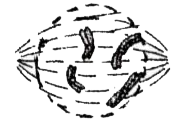Differentiate between :
Mitosis and Meiosis
Step-by-Step Text Solution:
1. Definition and Purpose:
- Mitosis: Mitosis is a type of cell division that occurs in somatic (body) cells. Its main purpose is to produce two genetically identical daughter cells for growth, repair, and asexual reproduction.
- Meiosis: Meiosis is a specialized type of cell division that occurs in reproductive cells (gametes) such as sperm and eggs. Its primary purpose is to reduce the chromosome number by half, producing four genetically diverse haploid cells.
2. Chromosome Number:
- Mitosis: The chromosome number in the daughter cells remains the same as that of the parent cell. If the parent cell is diploid (2n), the daughter cells will also be diploid (2n).
- Meiosis: The chromosome number is reduced by half. If the parent cell is diploid (2n), the resulting gametes will be haploid (n).
3. Pairing of Chromosomes:
- Mitosis: There is no pairing of homologous chromosomes. The chromosomes align individually during metaphase.
- Meiosis: Homologous chromosomes pair up during meiosis I, forming tetrads, which allows for crossing over and genetic recombination.
4. Genetic Variation:
- Mitosis: The daughter cells are genetically identical to each other and to the parent cell, as there is no exchange of genetic material.
- Meiosis: The daughter cells are genetically diverse due to the processes of crossing over and independent assortment of chromosomes.
5. Number of Divisions:
- Mitosis: Involves one division, resulting in two daughter cells.
- Meiosis: Involves two divisions (meiosis I and meiosis II), resulting in four daughter cells.
6. Stages of Division:
- Mitosis: Consists of prophase, metaphase, anaphase, and telophase, followed by cytokinesis.
- Meiosis: Consists of two rounds of division: meiosis I (which includes prophase I, metaphase I, anaphase I, and telophase I) and meiosis II (which includes prophase II, metaphase II, anaphase II, and telophase II).
Summary Table:
| Feature | Mitosis | Meiosis |
|-----------------------------|-------------------------------------------|-------------------------------------------|
| Type of Cells | Somatic cells | Reproductive cells (gametes) |
| Chromosome Number | Remains the same (2n) | Reduced by half (n) |
| Pairing of Chromosomes | Absent | Present (homologous chromosomes pair) |
| Genetic Variation | Genetically identical | Genetically diverse |
| Number of Divisions | One division | Two divisions |
| Stages | Prophase, Metaphase, Anaphase, Telophase | Meiosis I and Meiosis II |
- Mitosis: Mitosis is a type of cell division that occurs in somatic (body) cells. Its main purpose is to produce two genetically identical daughter cells for growth, repair, and asexual reproduction.
- Meiosis: Meiosis is a specialized type of cell division that occurs in reproductive cells (gametes) such as sperm and eggs. Its primary purpose is to reduce the chromosome number by half, producing four genetically diverse haploid cells.
- Mitosis: The chromosome number in the daughter cells remains the same as that of the parent cell. If the parent cell is diploid (2n), the daughter cells will also be diploid (2n).
- Meiosis: The chromosome number is reduced by half. If the parent cell is diploid (2n), the resulting gametes will be haploid (n).
- Mitosis: There is no pairing of homologous chromosomes. The chromosomes align individually during metaphase.
- Meiosis: Homologous chromosomes pair up during meiosis I, forming tetrads, which allows for crossing over and genetic recombination.
- Mitosis: The daughter cells are genetically identical to each other and to the parent cell, as there is no exchange of genetic material.
- Meiosis: The daughter cells are genetically diverse due to the processes of crossing over and independent assortment of chromosomes.
- Mitosis: Involves one division, resulting in two daughter cells.
- Meiosis: Involves two divisions (meiosis I and meiosis II), resulting in four daughter cells.
- Mitosis: Consists of prophase, metaphase, anaphase, and telophase, followed by cytokinesis.
- Meiosis: Consists of two rounds of division: meiosis I (which includes prophase I, metaphase I, anaphase I, and telophase I) and meiosis II (which includes prophase II, metaphase II, anaphase II, and telophase II).
|-----------------------------|-------------------------------------------|-------------------------------------------|
| Type of Cells | Somatic cells | Reproductive cells (gametes) |
| Chromosome Number | Remains the same (2n) | Reduced by half (n) |
| Pairing of Chromosomes | Absent | Present (homologous chromosomes pair) |
| Genetic Variation | Genetically identical | Genetically diverse |
| Number of Divisions | One division | Two divisions |
| Stages | Prophase, Metaphase, Anaphase, Telophase | Meiosis I and Meiosis II |
Topper's Solved these Questions
Similar Questions
Given below is a diagram representing a stage during mitotic cell division.
Study it carefully and answer the questions that follow:

How will you differentiate between mitosis and meiosis on the basis of the chromosome number in the daughter cells?
View SolutionDifferentiate between :
Diffusion and Osmosis
View SolutionDifferentiate between Tissue and organ
View SolutionDifferentiate between :
Haploid and Diploid
View SolutionDifferentiate between cations and anions
View SolutionDifferentiate between :
Disinfectant and deodorant,
View SolutionDifferentiate between Pinocytosis and phagocytosis
View SolutionDifferentiate between Liverworts and Mosses
View SolutionDifferentiate between Lysosomes and peroxisomes
View SolutionDifferentiate between : Excretion and Egestion
View Solution